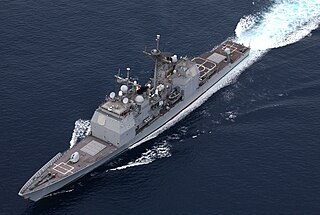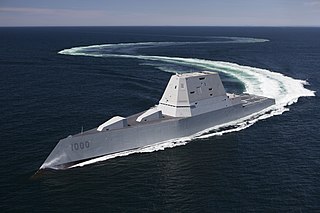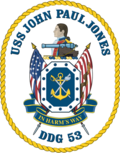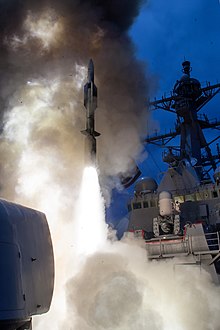
The Arleigh Burke class of guided-missile destroyers (DDGs) is a United States Navy class of destroyer centered around the Aegis Combat System and the SPY-1D multi-function passive electronically scanned array radar. The class is named for Admiral Arleigh Burke, an American destroyer officer in World War II and later Chief of Naval Operations. With an overall length of 505 to 509.5 feet, displacement ranging from 8,300 to 9,700 tons, and weaponry including over 90 missiles, the Arleigh Burke-class destroyers are larger and more heavily armed than many previous classes of guided-missile cruisers.

The Aegis Combat System is an American integrated naval weapons system, which uses computers and radars to track and guide weapons to destroy enemy targets. It was developed by the Missile and Surface Radar Division of RCA, and it is now produced by Lockheed Martin.

USS Decatur (DDG-73) is an Arleigh Burke-class destroyer in the United States Navy. She is named for the former naval officer Stephen Decatur, Jr. This ship is the 22nd destroyer of her class. USS Decatur was the 13th ship of this class to be built at Bath Iron Works in Bath, Maine, and construction began on 11 January 1996. She was launched on 10 November 1996 and was christened on 8 November 1996. On 29 August 1998 she was commissioned at the Tom McCall Waterfront Park in Portland, Oregon.

USS Hopper (DDG-70) is an Arleigh Burke-class guided missile destroyer of the United States Navy, named for the pioneering computer scientist Rear Admiral Grace Hopper.

USS Arleigh Burke (DDG-51), named for Admiral Arleigh A. Burke, USN (1901–1996), is the lead ship of the Arleigh Burke-class guided-missile destroyers. She was laid down by the Bath Iron Works company at Bath, Maine, on 6 December 1988; launched on 16 September 1989; and commissioned on 4 July 1991.

The Spruance-class destroyer was developed by the United States to replace the many World War II–built Allen M. Sumner- and Gearing-class destroyers, and was the primary destroyer built for the United States Navy during the 1970s and 1980s. It was named in honor of U.S. Navy Admiral Raymond A. Spruance, who successfully led major naval battles in the Asiatic-Pacific Theater during World War II such as the Battle of Midway and the Battle of the Philippine Sea.

USS Barry (DDG-52) is an Arleigh Burke-class guided missile destroyer, commissioned in 1992. Barry is the fourth United States Navy ship named after the "Father of the American Navy", Commodore John Barry (1745–1803). Her homeport is Naval Station Everett, Washington. Several improvements over Arleigh Burke exist on this ship and all following Arleigh Burke-class destroyers, such as the ability to refuel a helicopter.

USS Donald Cook (DDG-75) is an Arleigh Burke-class guided missile destroyer in the United States Navy named for Medal of Honor recipient Donald Cook, a colonel in the United States Marine Corps. This ship is the 25th destroyer of her class and the 14th of the class to be built at Bath Iron Works in Bath, Maine. Construction began on 9 July 1996, she was launched and christened on 3 May 1997, and on 4 December 1998, she was commissioned at Penn's Landing Pier in Philadelphia, Pennsylvania.

The Ticonderoga class of guided-missile cruisers is a class of warships of the United States Navy, first ordered and authorized in the 1978 fiscal year. It was originally planned as a class of destroyers. However, the increased combat capability offered by the Aegis Combat System and the passive phased array AN/SPY-1 radar, together with the capability of operating as a flagship, were used to justify the change of the classification from DDG to CG shortly before the keels were laid down for Ticonderoga and Yorktown.

USS Laboon (DDG-58) is an Arleigh Burke-class destroyer in the United States Navy. She is named for Father John Francis Laboon (1921–1988), a captain in the Chaplain Corps of the United States Navy, who was awarded the Silver Star during World War II while serving on the submarine USS Peto.

USS Benfold (DDG-65) is a Flight I Arleigh Burke-class destroyer in the United States Navy. She is a multi-mission platform capable of anti-aircraft warfare (AAW) with the powerful Aegis Combat System suite and anti-aircraft missiles, anti-submarine warfare (ASW), with towed sonar array, anti-submarine rockets, anti-surface warfare (ASUW) with Harpoon missiles, and strategic land strike using Tomahawk missiles. Benfold was one of the first ships fitted with the Aegis Ballistic Missile Defense System and during the 2010 Stellar Daggers exercise was the first ship to simultaneously engage a ballistic missile and a cruise missile.

USS Ross (DDG-71) is an Arleigh Burke-class guided-missile destroyer in the United States Navy. She is the second Navy ship to be named Ross, the first Navy ship named for Medal of Honor recipient Donald K. Ross and the 21st destroyer of her class. The first Ross, DD-563, was named for David Ross, a captain in the Continental Navy.

USS Mahan (DDG-72) is an Arleigh Burke-class destroyer currently in service with the United States Navy. This ship is the 22nd destroyer of her class. USS Mahan was the 12th ship of this class to be built at Bath Iron Works in Bath, Maine, and construction began on 17 August 1995. She was launched and christened on 29 June 1996. On 14 February 1998 she was commissioned in Tampa, Florida. Mahan is homeported in Norfolk, Virginia, and as of 2012 was attached to Destroyer Squadron 2. By 2016, the ship was part of Destroyer Squadron 22.

USS O'Kane (DDG-77) is an Arleigh Burke-class destroyer in the United States Navy. The ship was built by Bath Iron Works in Bath, Maine, starting on 8 May 1997. The ship was commissioned on 23 October 1999. She is named for Medal of Honor recipient Rear Admiral Richard O'Kane.

The Zumwalt-class destroyer is a class of three United States Navy guided-missile destroyers designed as multi-mission stealth ships with a focus on land attack. It is a multi-role class that was designed with a primary role of naval gunfire support and secondary roles of surface warfare and anti-aircraft warfare. The class design emerged from the DD-21 "land attack destroyer" program as "DD(X)" and was intended to take the role of battleships in meeting a congressional mandate for naval fire support. The ship is designed around its two Advanced Gun Systems (AGS), turrets with 920 round magazines, and unique Long Range Land Attack Projectile (LRLAP) ammunition. LRLAP procurement was canceled, rendering the guns unusable, so the Navy re-purposed the ships for surface warfare. Starting in 2023, the Navy will remove the AGS from the ships and replace them with hypersonic missiles.

The Kongō class of guided-missile destroyers in the Japan Maritime Self-Defense Force are equipped with the Aegis Combat System, and is the first of few ship classes outside the United States to have that capability. Following a decision made in December 2003, Japan is upgrading their Kongo-class destroyers with Aegis Ballistic Missile Defense System. The upgrade involves a series of installations and flight tests to take place from 2007 to 2010. JS Kongo was the first ship to have the BMD upgrade installed.

USS Ralph Johnson (DDG-114) is an Arleigh Burke-class destroyer of the United States Navy. Ralph Johnson is the 64th ship of the class and was commissioned on 24 March 2018.

USS John Finn (DDG-113) is an Arleigh Burke-class destroyer in service with the United States Navy. The contract to build her was awarded to Ingalls Shipbuilding of Pascagoula, Mississippi, on 15 June 2011. Ingalls has been a subsidiary of Huntington Ingalls Industries (HII) since its acquisition in April 2001. Prior to the award, Ingalls had constructed 28 Arleigh Burke-class destroyers, the last one of which was USS William P. Lawrence. On 15 February 2011, Secretary of the Navy Ray Mabus announced the ship's name to be John Finn after John William Finn, the first Medal of Honor recipient of World War II. He was so honored for machine-gunning Japanese warplanes for over two hours during the December 1941 attack on Pearl Harbor despite being shot in the foot and shoulder, and suffering numerous shrapnel wounds. He retired as a lieutenant after thirty years of service and died at age 100 in 2010.

USS Rafael Peralta (DDG-115) is an Arleigh Burke-class guided missile destroyer in the United States Navy. The destroyer can operate with a Carrier Strike Group (CSG), Expeditionary Strike Group (ESG), as an element of a Surface Action Group (SAG), or independently. The ship can conduct a variety of missions in support of national military strategy. From peacetime presence and crisis management to sea control and power projection, 115 will be capable of carrying out Integrated Air and Missile Defense (IAMD), Undersea Warfare (USW), Surface Warfare (SW), and Strike Warfare (STW) in multi-threat environments.

USS Thomas Hudner (DDG-116) is an Arleigh Burke-class destroyer. The $663 million contract to build her was awarded on 28 February 2012, to Bath Iron Works, of Bath, Maine. On 7 May 2012, Secretary of the Navy, Ray Mabus, announced the ship name would be named Thomas Hudner in honor of U.S. naval aviator Thomas Hudner, who was awarded the Medal of Honor for his actions in trying to save the life of his wingman, Ensign Jesse L. Brown, during the Battle of Chosin Reservoir, in the Korean War.






















